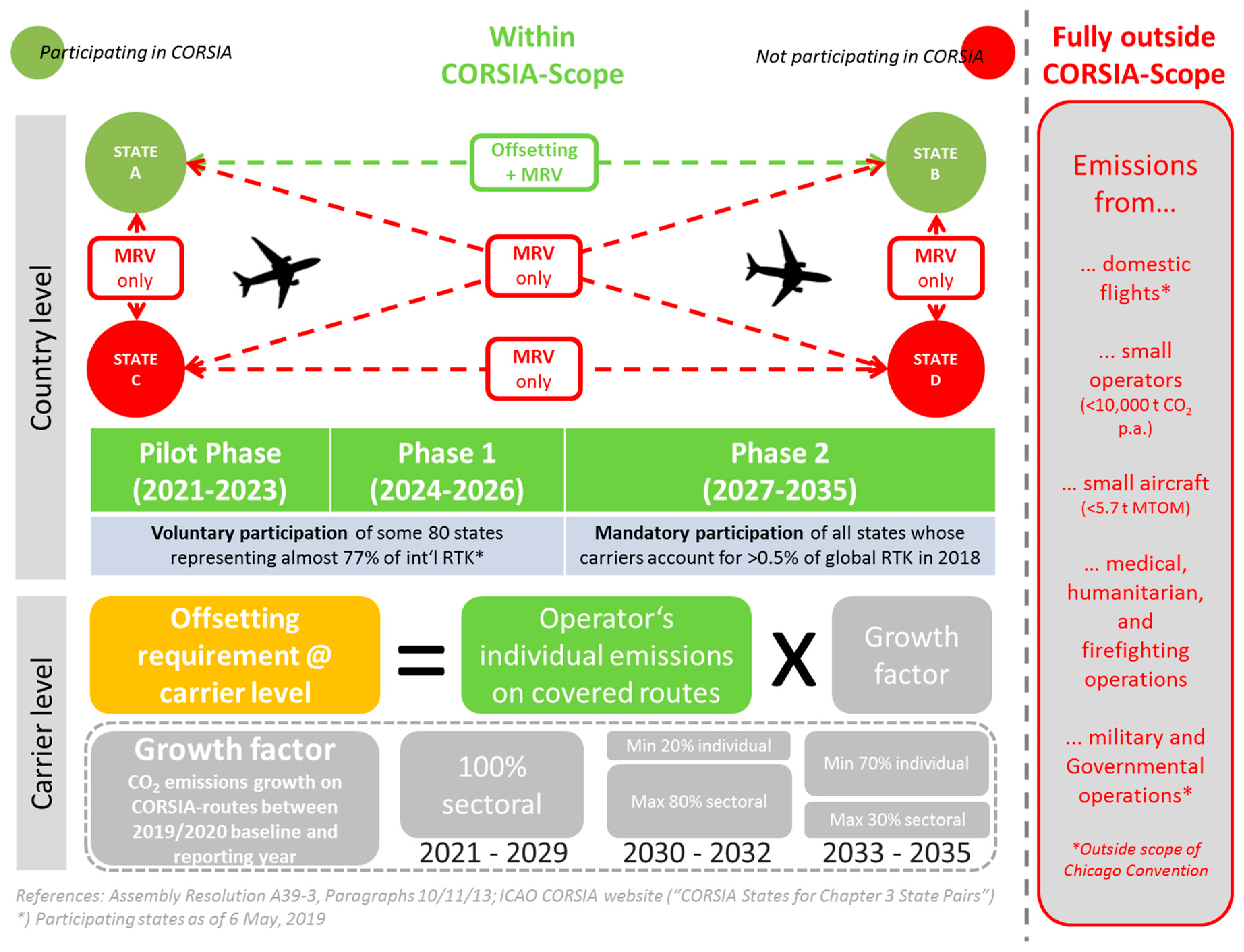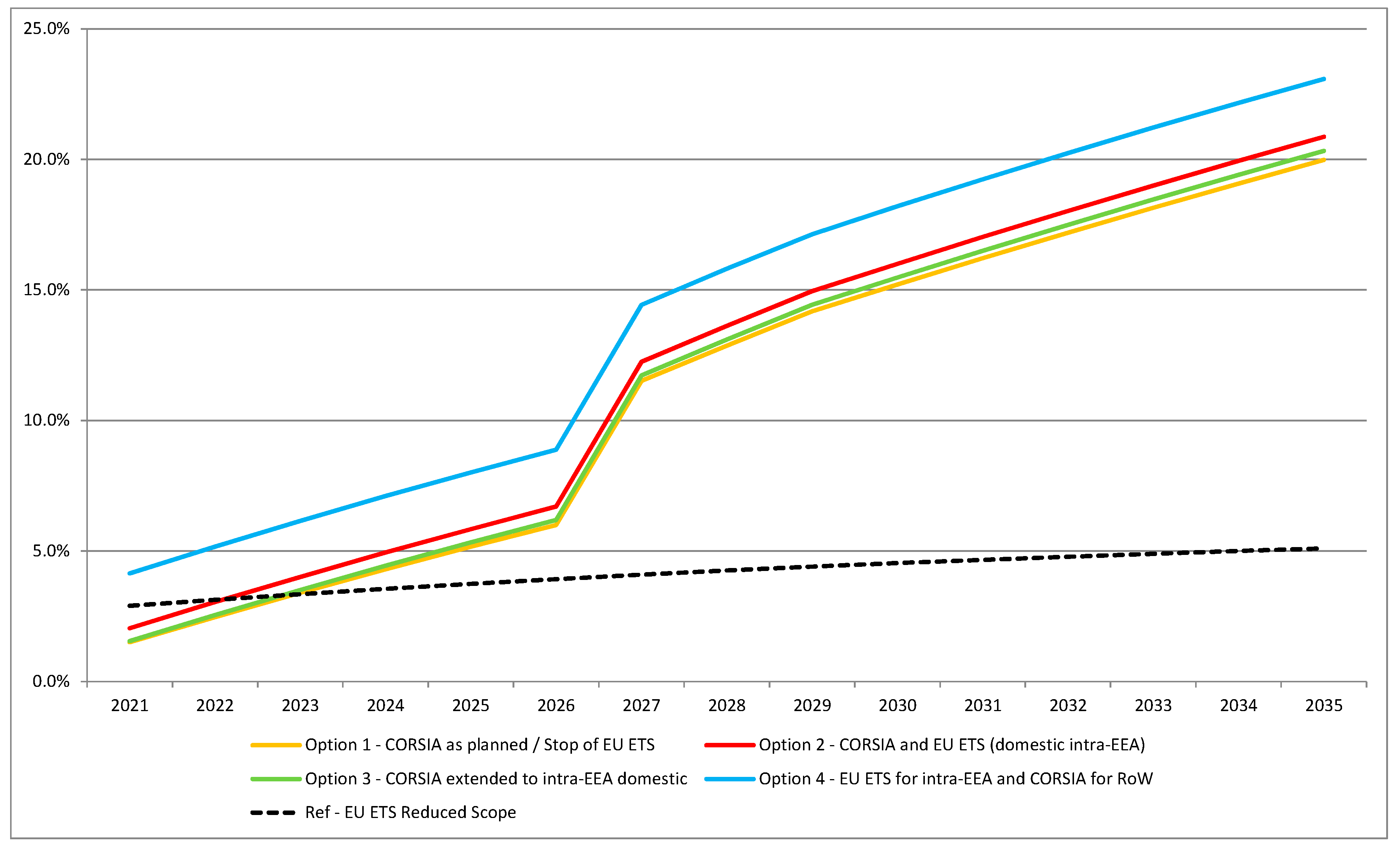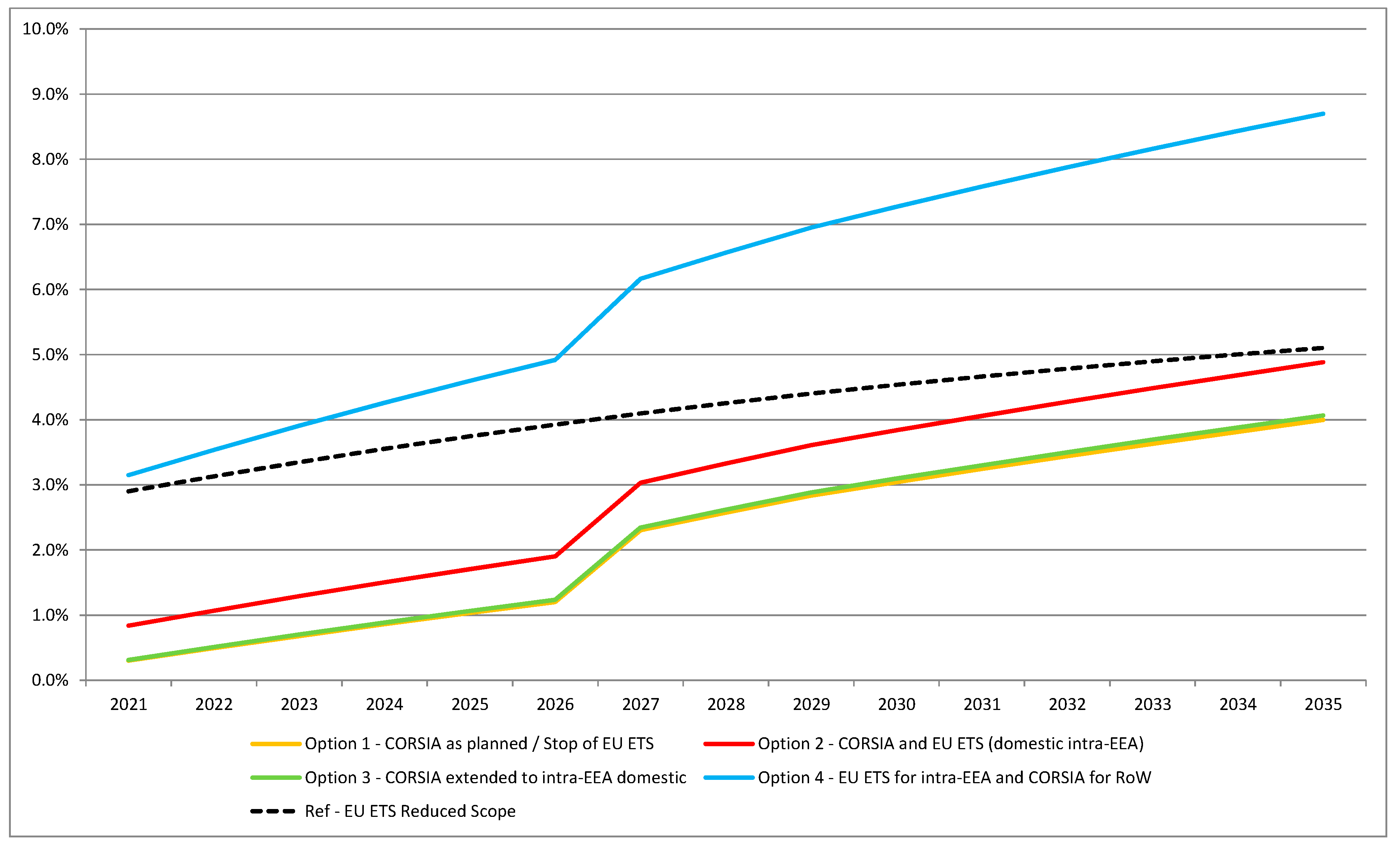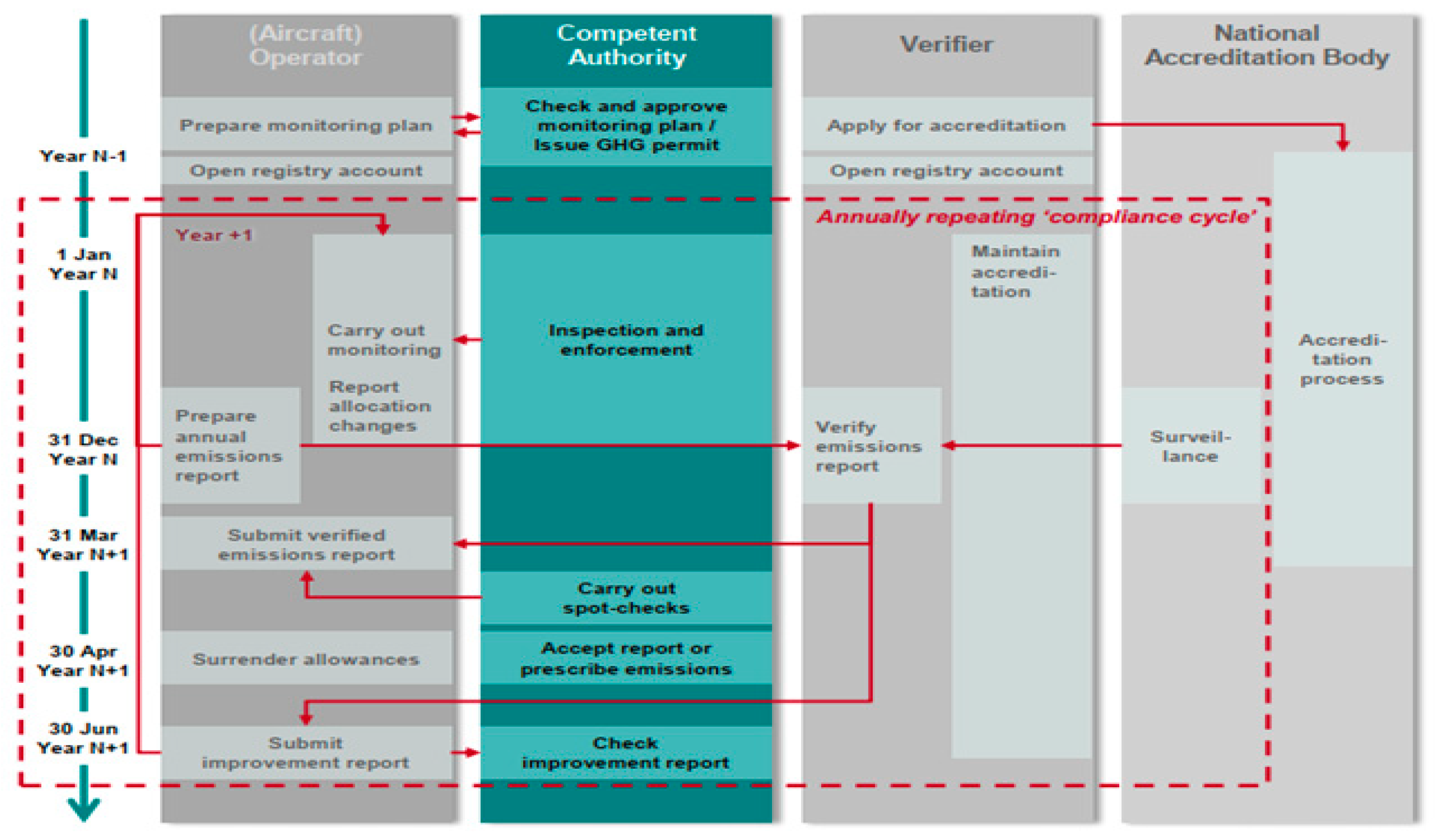Options to Continue the EU ETS for Aviation in a CORSIA-World
Abstract
1. Introduction
2. EU ETS vs. CORSIA
2.1. Genesis, Key Functioning, and Impacts of the EU ETS for Aviation
2.2. Introduction and Design of CORSIA
- Example:
- Airline A’s emissions on CORSIA routes amount to 4,912,000 tons of CO2 in 2021. The airline sector’s emission growth on CORSIA-routes between the baseline period and 2021 is 3.8%. Airline A’s offsetting requirement for 2021 is calculated as: 4,912,000 × 0.038 = 186,656 tons of CO2.
2.3. Key Similarities and Differences
3. Assessment of Options to Maintain the EU ETS in a CORSIA World
3.1. Range of Policy Options
- Implementation of CORSIA as planned and discontinuation of the EU ETS (“CORSIA only”);
- Implementation of CORSIA as planned and continuation of the EU ETS for domestic flights only (“CORSIA + EU ETS domestic”);
- Voluntary extension of CORSIA to domestic EEA flights and discontinuation of the EU ETS (“CORSIA also for EEA domestic”);
- Application of CORSIA to flights partly or fully outside the EEA only and full continuation of the reduced (=intra-EEA) scope of the EU ETS (“EU ETS for intra-EEA und CORSIA for RoW”).
3.2. Quantification of the Options’ Environmental Impacts
3.2.1. Methodology and Data
3.2.2. Results and Discussion—Annual Emission Reduction by Option
3.2.3. Results and Discussion—Impacts on Accumulated Emissions
3.3. MRV implications
- The main one-time task is the preparation (AO), check (CA), and approval (CA) of monitoring plans. This usually happens once for each aircraft operator under each of the schemes, be it when the MBM is introduced, or in case a new carrier joins the measure, or if there are any significant changes, such as the fuel estimation methodology, IT systems of relevance, or the organizational structure [39]. For the EU ETS, Article 14(2) of the “Monitoring and Reporting Regulation (MRR)” EU No 601/2012 [40] includes a minimum list of the typical changes which would require an update of the monitoring plan;
- During the compliance cycle, each AO has to compile an annual emissions report for the preceding year and provide it to its CA, together with a verification report prepared by a verifier;
- The CA is required to ensure that the emissions have been monitored and reported in accordance with the legislation (e.g., the MRR for the EU ETS). It will perform full or spot checks and may request an improvement report or start legal action.
- Technical exemptions, especially regarding exempted flight categories, aircraft types, routes, and operators;
- Eligible fuel monitoring methods and thresholds for simplified monitoring methods;
- MRV for flights between non-EEA countries: Mandatory under CORSIA but voluntary in the according to the delegated regulation;
- Country of accreditation of verifiers.
4. Summary and Conclusions
Author Contributions
Funding
Acknowledgments
Conflicts of Interest
References
- Intergovernmental Panel on Climate Change (IPCC). Aviation and the Global Atmosphere; A Special Report of IPCC Working Groups I and III; Cambridge University Press: Cambridge, UK, 1999; Available online: http://www.grida.no/climate/ipcc/aviation/index.htm (accessed on 8 May 2019).
- Lee, D.S.; Fahey, D.W.; Forster, P.M.; Newton, P.J.; Wit, R.C.; Lim, L.L.; Owen, B.; Sausen, R. Aviation and global climate change in the 21st century. Atmos. Environ. 2009, 43, 3520–3537. [Google Scholar] [CrossRef]
- International Energy Agency (IEA). CO2 Emissions from Fuel Combustion (Excel Database). 2017. Available online: https://www.iea.org/media/statistics/CO2Highlights.XLS (accessed on 22 January 2019).
- Airbus. Global Networks, Global Citizens. Global Market Forecast, 2018–2037. 2018. Available online: https://www.airbus.com/content/dam/corporate-topics/publications/media-day/GMF-2018-2037.pdf (accessed on 8 May 2019).
- United Nations Framework Convention on Climate Change (UNFCCC). Adoption of the Paris Agreement, Conference of the Parties, Twenty-First Session (COP 21); United Nations Framework Convention on Climate Change: Paris, France, 2015; Available online: http://unfccc.int/resource/docs/2015/cop21/eng/l09r01.pdf (accessed on 24 May 2019).
- United Nations Framework Convention on Climate Change (UNFCCC). Kyoto Protocol to the United Nations Framework Convention on Climate Change. 1997. Available online: http://unfccc.int/resource/docs/convkp/kpeng.pdf (accessed on 8 May 2019).
- International Civil Aviation Organisation (ICAO). Resolution A39-3: Consolidated Statement of Continuing ICAO Policies and Practices Related to Environmental Protection—Global Market-based Measure (MBM) Scheme; International Civil Aviation Organisation: Montréal, QC, Canada, 2016; Available online: https://www.icao.int/environmental.../resolution_a39_3.pdf (accessed on 8 May 2019).
- Preston, H.; Lee, D.S.; Hooper, P.D. The inclusion of the aviation sector within the European Union’s Emissions Trading Scheme: What are the prospects for a more sustainable aviation industry? Environ. Dev. 2012, 2, 48–56. [Google Scholar] [CrossRef]
- European Union (EU). Directive 2008/101/EC of the European Parliament and the Council of 19 November 2008 amending Directive 2003/87/EC so as to Include Aviation Activities in the Scheme for Greenhouse Gas Emission Allowance Trading within the Community. Off. J. Eur. Union 2009, 8, 3–21. Available online: https://eur-lex.europa.eu/legal-content/EN/TXT/PDF/?uri=CELEX:32008L0101&from=EN (accessed on 8 May 2019).
- European Union (EU). Directive 2009/29/EC of the European Parliament and of the Council Amending Directive 2003/87/EC so as to Improve and Extend the Greenhouse Gas Emission Allowance Trading System of the Community. Off. J. Eur. Union 2009, 140, 63–87. Available online: https://eur-lex.europa.eu/legal-content/EN/TXT/PDF/?uri=CELEX:32009L0029&from=EN (accessed on 8 May 2019).
- European Commission. The EU Emissions Trading System (EU ETS). 2016. Available online: https://ec.europa.eu/clima/sites/clima/files/factsheet_ets_en.pdf (accessed on 8 May 2019).
- European Commission. Reducing Emissions from Aviation. 2019. Available online: https://ec.europa.eu/clima/policies/transport/aviation_en#tab-0-2 (accessed on 8 May 2019).
- Anger, A.; Köhler, J. Including aviation emissions into the EU ETS: much ado about nothing? A review. Transport Pol. 2010, 17, 38–46. [Google Scholar] [CrossRef]
- Scheelhaase, J.; Schaefer, M.; Grimme, W.; Maertens, S. Cost impacts of the inclusion of air transport into the European Emissions Trading Scheme in the period 2012–2020. Eur. J. Transp. Infrastruct. Res. 2012, 12, 332–348. [Google Scholar]
- European Commission. Allocation to Aviation. 2019b. Available online: https://ec.europa.eu/clima/policies/ets/allowances/aviation_en (accessed on 8 May 2019).
- European Union (EU). Regulation (EU) 2017/2392 of the European Parliament and of the Council of 13 December 2017 amending Directive 2003/87/EC to continue current limitations of scope for aviation activities and to prepare to implement a global market-based measure from 2021. Off. J. Eur. Union 2017, 350, 7–14. Available online: https://eur-lex.europa.eu/legal-content/EN/TXT/PDF/?uri=CELEX:32017R2392&from=EN (accessed on 8 May 2019).
- Bartels, L. The WTO legality of the application of the EU’s emission trading system to aviation. Eur. J. Int. Law 2012, 23, 429–467. [Google Scholar] [CrossRef]
- European Parliament. Briefing, EU Legislation in Progress, CO2 Emissions from Aviation. 2018. Available online: http://www.europarl.europa.eu/RegData/etudes/BRIE/2017/603925/EPRS_BRI(2017)603925_EN.pdf (accessed on 8 May 2019).
- European Union (EU). Decision No 377/2013/EU of the European Parliament and of the Council of 24 April 2013 Derogating Temporarily from Directive 2003/87/EC Establishing a Scheme for Greenhouse Gas Emission Allowance Trading within the Community. Off. J. Eur. Union 2013, 113, 1–4. Available online: https://eur-lex.europa.eu/legal-content/EN/TXT/PDF/?uri=CELEX:32013D0377&from=EN (accessed on 8 May 2019).
- Albers, S.; Bühne, J.A.; Peters, H. Will the EU ETS instigate airline network reconfigurations? J. Air Transp. Manag. 2009, 15, 1–6. [Google Scholar] [CrossRef]
- Scheelhaase, J. How to regulate aviation’s full climate impact as intended by the EU council from 2020 onwards. J. Air Transp. Manag. 2019, 75, 68–74. [Google Scholar] [CrossRef]
- International Civil Aviation Organisation (ICAO). Annex 16 to the Convention on International Civil Aviation, Environmental Protection; Carbon Offsetting and Reduction Scheme for International Aviation (CORSIA): Montréal, QC, Cananda, 2018; Volume IV. [Google Scholar]
- International Civil Aviation Organisation (ICAO). Top 3 Misconceptions about CORSIA. 2019a. Available online: https://www.icao.int/environmental-protection/Pages/A39_CORSIA_FAQ6.aspx (accessed on 8 May 2019).
- International Civil Aviation Organisation (ICAO). CORSIA States for Chapter 3 State Pairs. 2019b. Available online: https://www.icao.int/environmental-protection/CORSIA/Pages/state-pairs.aspx (accessed on 30 August 2019).
- Hedley, A.; Rock, N.; Zaman, P. First Ever Global Regime for Aviation Emissions: ICAO Adopts Global Market-Based Measure to Combat Aircraft CO2 Emissions. Reed Smith Client Alerts. 10 October 2016. Available online: https://www.reedsmith.com/en/perspectives/2016/10/first-ever-global-regime-for-aviation-emissions-ic (accessed on 8 May 2019).
- Schep, E.; van Velzen, A.; Faber, J. A Comparison between CORSIA and the EU ETS for Aviation. Delft. 2016. Available online: https://www.transportenvironment.org/sites/te/files/publications/2016_12_CE_Delft_ETS_CORSIA_final.pdf (accessed on 8 May 2019).
- Scheelhaase, J.; Maertens, S.; Grimme, W.; Jung, M. EU ETS versus CORSIA—A critical assessment of two approaches to limit air transport’s CO2 emissions by market-based measures. J. Air Transp. Manag. 2018, 67, 55–62. [Google Scholar] [CrossRef]
- Gold Standard. A Higher Standard for Climate Security and Sustainable Development. 2019. Available online: https://www.goldstandard.org/impact-quantification/gold-standard-global-goals (accessed on 30 August 2019).
- Carbon Market Watch. Additionality & Baselines. 2012. Available online: https://carbonmarketwatch.org/2012/05/30/additionality-and-baselines/ (accessed on 30 August 2019).
- Greenair Communications. ICAO Council Approves Criteria for CORSIA Emissions Units and structure for New Body Overseeing Eligibility. 6 March 2019. Available online: https://www.greenaironline.com/news.php?viewStory=2573 (accessed on 8 May 2019).
- Larsson, J.; Elofsson, A.; Sterner, T.; Akerman, J. International and national climate policies for aviation: a review. Climate Pol. 2019, 19, 787–7099. Available online: https://doi.org/10.1080/14693062.2018.1562871 (accessed on 24 May 2019). [CrossRef]
- Timperley, J. CORSIA: The UN’s Plan to ‘Offset’ Growth in Aviation Emissions after 2020. Carbon Brief 04.02.2019. Available online: https://www.carbonbrief.org/corsia-un-plan-to-offset-growth-in-aviation-emissions-after-2020 (accessed on 24 May 2019).
- Cames, M.; Harthan, R.O.; Füssler, J.R.; Lazarus, M.; Lee, C.M.; Erickson, P.; Spalding-Fecher, R. How Additional is the Clean Development Mechanism? Analysis of the Application of Current Tools and Proposed Alternatives (No. CLlMA.B.3/SERl2013/0026r); Öko-Institut: Berlin, Germany, 2016; Available online: https://ec.europa.eu/clima/sites/clima/files/ets/docs/clean_dev_mechanism_en.pdf (accessed on 8 October 2019).
- European Commission. Commission Delegated Regulation (EU) …/... of 6.3.2019 Supplementing Directive 2003/87/EC of the European Parliament and of the Council as Regards Measures adopted by the International Civil Aviation Organisation for the Monitoring, Reporting and Verification of Aviation Emissions for the Purpose of Implementing a Global Market-Based Measure. 2019c. Available online: https://eur-lex.europa.eu/legal-content/EN/TXT/PDF/?uri=PI_COM:C(2019)1644&from=EN (accessed on 8 May 2019).
- Van Velzen. CORSIA, EU ETS and the EU2030 Aviation Emissions Target. Report prepared for Transport and Environment (T&E). Report nr 18-13. 2018. Available online: https://www.transportenvironment.org/sites/te/files/publications/2018_09_Study_CORSIA_EU_ETS_and_EU2030_aviation_emissions_target_Final.pdf (accessed on 30 August 2019).
- Team_Play. AERO-MS. 2013. Available online: https://trimis.ec.europa.eu/sites/default/files/project/documents/20130218_181700_44187_TeamPlay_ToolDescriptionAEROMS.pdf (accessed on 23 May 2019).
- International Civil Aviation Organisation (ICAO). FESG Traffic and Fleet Forecasts—Methodological Paper; Unpublished Working Paper; International Civil Aviation Organisation: Montreal, QC, Cananda, 3 June 2014. [Google Scholar]
- International Air Transport Association (IATA). Fact Sheet: CORSIA and Carbon Pricing, 12 May 2019. Available online: https://www.iata.org/policy/environment/Documents/corsia-factsheet-carbon-pricing.pdf (accessed on 8 October 2019).
- European Commission. Guidance Document, The Monitoring and Reporting Regulation – General guidance for Aircraft Operators, MRR Guidance document No. 2, Updated Version, 11 January 2018. Directorate-General Climate Action, Directorate C—Climate Strategy, Governance and Emissions from non-trading sectors, Unit C.2—Governance and Effort Sharing. Available online: https://ec.europa.eu/clima/sites/clima/files/ets/monitoring/docs/gd2_guidance_aircraft_en.pdf (accessed on 30 August 2019).
- European Union (EU). Commission Regulation (EU) No 601/2012 of 21 June 2012 on the monitoring and reporting of greenhouse gas emissions pursuant to Directive 2003/87/EC of the European Parliament and of the Council. Off. J. Eur. Union 2012, 181, 30–104. Available online: https://eur-lex.europa.eu/legal-content/EN/TXT/PDF/?uri=CELEX:32012R0601&from=EN (accessed on 30 August 2019).
- European Commission. EU ETS Monitoring, Reporting, Verification and Accreditation—Quick guide for Competent Authorities, Version of 9 November 2017. Directorate-General Climate Action, Directorate C—Climate Strategy, Governance, and Emissions from Non-Trading Sectors, CLIMA.C.2—Governance & Effort Sharing. Available online: https://ec.europa.eu/clima/sites/clima/files/ets/monitoring/docs/quick_guide_ca_en.pdf (accessed on 30 August 2019).
- International Air Transport Association (IATA). Comments on the Commission’s Draft Delegated Regulation on Reporting Measures to Implement CORSIA. 12 December 2018. Available online: https://ec.europa.eu/info/law/better-regulation/feedback/15893/attachment/090166e5c002b4cc_it (accessed on 8 May 2019).





| 1. Albania 2. Armenia 3. Australia 4. Austria 5. Azerbaijan 6. Belgium 7. Bosnia and Herzegovina 8. Botswana 9. Bulgaria 10. Burkina Faso 11. Cameroon 12. Canada 13. Costa Rica 14. Croatia 15. Cyprus 16. Czech Republic 17. Democratic Republic of Congo 18. Denmark 19. Dominican Republic 20. El Salvador 21. Equatorial Guinea | 22. Estonia 23. Finland 24. France 25. Gabon 26. Georgia 27. Germany 28. Ghana 29. Greece 30. Guatemala 31. Guyana 32. Hungary 33. Iceland 34. Indonesia 35. Ireland 36. Israel 37. Italy 38. Jamaica 39. Japan 40. Kenya 41. Latvia 42. Lithuania 43. Luxembourg | 44. Malaysia 45. Malta 46. Marshall Islands 47. Mexico 48. Monaco 49. Montenegro 50. Namibia 51. Netherlands 52. New Zealand 53. Nigeria 54. North Macedonia 55. Norway 56. Papua New Guinea 57. Philippines 58. Poland 59. Portugal 60. Qatar 61. Republic of Korea 62. Republic of Moldova 63. Romania 64. San Marino 65. Saudi Arabia | 66. Serbia 67. Singapore 68. Slovakia 69. Slovenia 70. Spain 71. Sweden 72. Switzerland 73. Thailand 74. Turkey 75. Uganda 76. Ukraine 77. United Arab Emirates 78. United Kingdom 79. United States 80. Zambia |
| Scheme | EU ETS | CORSIA | |
|---|---|---|---|
| Fundamental differences | Methodology | Cap & Trade | Baseline & Credit (Offsetting) |
| Environmental integrity | Not critical, overall cap is fixed | Dependent on offset quality standards and enforcement | |
| Need for verification by authorities | Only at emitter level | Both at emitter and at offsetting project level | |
| Differences in actual implementation and application (coverage & baseline) | Cap/Baseline | 95% of avg. 2004/2006 emissions; stepwise further reduction of cap envisaged | Avg. 2019/2020 emissions; no further reduction envisaged |
| Scope | Intra-EEA including domestic flights | International routes between participating states | |
| Affected carriers | All airlines operating on covered routes, unless exceptions apply | ||
| Affected aircraft Types | Fixed wing (>5.7 t MTOM) and helicopters | Fixed wing (>5.7 t MTOM) | |
| Years | 2021 | Share of Total | 2027 | Share of Total |
|---|---|---|---|---|
| Total emissions (Mt) | 887.0 | 100.0% | 1080.6 | 100.0% |
| of which subject to CORSIA | 316.6 | 35.7% | 561.9 | 52.0% |
| of which subject to EU ETS | 72.3 | 8.1% | 84.5 | 7.8% |
| Route Group | Intra-EEA (domestic **) | Intra-EEA (int’l) | EEA–RoW | RoW–RoW (int’l) | RoW (domestic) ** |
|---|---|---|---|---|---|
| Sample country-pairs | Intra-Italy Intra-Norway | Poland–Belgium Spain–Norway | France–Japan Norway–USA | USA–Canada UAE–Ghana | Intra-USA Intra-China |
| Option 1 “CORSIA only” | --- | CORSIA | CORSIA * | CORSIA * | --- |
| Option 2 “CORSIA + EU ETS for EEA domestic” | EU ETS | CORSIA | CORSIA * | CORSIA * | --- |
| Option 3 “CORSIA also for EEA domestic” | CORSIA | CORSIA | CORSIA * | CORSIA * | --- |
| Option 4 “EU ETS for intra-EEA & CORSIA for RoW” | EU ETS | EU ETS | CORSIA * | CORSIA * | --- |
| Year | Option 1—CORSIA Only | Option 2—CORSIA + EU ETS for EEA Domestic | Option 3—CORSIA also for EEA Domestic | Option 4—EU ETS for Intra-EEA and CORSIA for RoW | Ref—EU ETS Reduced Scope |
|---|---|---|---|---|---|
| 2016 | 2.1% | ||||
| 2017 | 2.2% | ||||
| 2018 | 2.4% | ||||
| 2019 | 2.5% | ||||
| 2020 | 2.7% | ||||
| 2021 | 1.5% | 2.0% | 1.6% | 4.1% | 2.9% |
| 2022 | 2.5% | 3.0% | 2.5% | 5.2% | 3.1% |
| 2023 | 3.4% | 4.0% | 3.5% | 6.2% | 3.3% |
| 2024 | 4.3% | 4.9% | 4.4% | 7.1% | 3.6% |
| 2025 | 5.2% | 5.8% | 5.3% | 8.0% | 3.7% |
| 2026 | 6.0% | 6.7% | 6.2% | 8.9% | 3.9% |
| 2027 | 11.5% | 12.2% | 11.7% | 14.4% | 4.1% |
| 2028 | 12.9% | 13.6% | 13.1% | 15.8% | 4.3% |
| 2029 | 14.2% | 15.0% | 14.4% | 17.1% | 4.4% |
| 2030 | 15.2% | 16.0% | 15.5% | 18.2% | 4.5% |
| 2031 | 16.2% | 17.0% | 16.5% | 19.2% | 4.7% |
| 2032 | 17.2% | 18.0% | 17.5% | 20.2% | 4.8% |
| 2033 | 18.1% | 19.0% | 18.5% | 21.2% | 4.9% |
| 2034 | 19.1% | 19.9% | 19.4% | 22.2% | 5.0% |
| 2035 | 20.0% | 20.9% | 20.3% | 23.1% | 5.1% |
| Year | Option 1—CORSIA Only | Option 2—CORSIA + EU ETS for EEA Domestic | Option 3—CORSIA also for EEA Domestic | Option 4—EU ETS for intra-EEA and CORSIA for RoW | Ref—EU ETS Reduced Scope |
|---|---|---|---|---|---|
| 2016 | 2.1% | ||||
| 2017 | 2.2% | ||||
| 2018 | 2.4% | ||||
| 2019 | 2.5% | ||||
| 2020 | 2.7% | ||||
| 2021 | 0.3% | 0.8% | 0.3% | 3.1% | 2.9% |
| 2022 | 0.5% | 1.1% | 0.5% | 3.5% | 3.1% |
| 2023 | 0.7% | 1.3% | 0.7% | 3.9% | 3.3% |
| 2024 | 0.9% | 1.5% | 0.9% | 4.3% | 3.6% |
| 2025 | 1.0% | 1.7% | 1.1% | 4.6% | 3.7% |
| 2026 | 1.2% | 1.9% | 1.2% | 4.9% | 3.9% |
| 2027 | 2.3% | 3.0% | 2.3% | 6.2% | 4.1% |
| 2028 | 2.6% | 3.3% | 2.6% | 6.6% | 4.3% |
| 2029 | 2.8% | 3.6% | 2.9% | 6.9% | 4.4% |
| 2030 | 3.0% | 3.8% | 3.1% | 7.3% | 4.5% |
| 2031 | 3.2% | 4.1% | 3.3% | 7.6% | 4.7% |
| 2032 | 3.4% | 4.3% | 3.5% | 7.9% | 4.8% |
| 2033 | 3.6% | 4.5% | 3.7% | 8.2% | 4.9% |
| 2034 | 3.8% | 4.7% | 3.9% | 8.4% | 5.0% |
| 2035 | 4.0% | 4.9% | 4.1% | 8.7% | 5.1% |
| Period (2021 to …) | No measure (Mt CO2) | EU ETS (ref) (Mt CO2) | Option 1 (CORSIA only) (Mt CO2) | Option 2 (CORSIA + EU ETS domestic) (Mt CO2) | Option 3 (CORSIA extension to EEA domestic, no ETS) (Mt CO2) | Option 4 (EU ETS for intra-EEA and CORSIA for RoW) (Mt CO2) | ||||
|---|---|---|---|---|---|---|---|---|---|---|
| CER effectiveness rate | 100% | 20% | 100% | 20% | 100% | 20% | 100% | 20% | ||
| 2021 | 887 | 861 | 874 | 884 | 869 | 880 | 873 | 884 | 850 | 859 |
| 2022 | 1803 | 1749 | 1767 | 1796 | 1757 | 1786 | 1766 | 1796 | 1719 | 1743 |
| 2023 | 2750 | 2664 | 2682 | 2736 | 2666 | 2720 | 2679 | 2736 | 2607 | 2652 |
| 2024 | 3728 | 3607 | 3618 | 3706 | 3596 | 3684 | 3614 | 3705 | 3516 | 3589 |
| 2025 | 4739 | 4580 | 4577 | 4707 | 4548 | 4678 | 4572 | 4706 | 4446 | 4554 |
| 2026 | 5784 | 5585 | 5559 | 5739 | 5523 | 5703 | 5552 | 5738 | 5399 | 5547 |
| 2027 | 6865 | 6621 | 6515 | 6795 | 6471 | 6751 | 6506 | 6793 | 6323 | 6561 |
| 2028 | 7982 | 7691 | 7489 | 7884 | 7436 | 7831 | 7477 | 7881 | 7264 | 7606 |
| 2029 | 9138 | 8796 | 8481 | 9007 | 8419 | 8945 | 8466 | 9004 | 8222 | 8681 |
| 2030 | 10326 | 9930 | 9488 | 10158 | 9417 | 10087 | 9470 | 10155 | 9193 | 9782 |
| 2031 | 11546 | 11093 | 10510 | 11339 | 10430 | 11258 | 10489 | 11335 | 10179 | 10910 |
| 2032 | 12801 | 12288 | 11549 | 12550 | 11458 | 12459 | 11524 | 12545 | 11179 | 12066 |
| 2033 | 14090 | 13514 | 12605 | 13793 | 12502 | 13691 | 12575 | 13787 | 12195 | 13250 |
| 2034 | 15415 | 14773 | 13677 | 15068 | 13563 | 14954 | 13644 | 15061 | 13227 | 14464 |
| 2035 | 16778 | 16066 | 14767 | 16376 | 14642 | 16250 | 14729 | 16368 | 14275 | 15708 |
| Cumulative reduction compared to “no measure” | 712 | 2011 | 402 | 2136 | 528 | 2049 | 410 | 2503 | 1070 | |
© 2019 by the authors. Licensee MDPI, Basel, Switzerland. This article is an open access article distributed under the terms and conditions of the Creative Commons Attribution (CC BY) license (http://creativecommons.org/licenses/by/4.0/).
Share and Cite
Maertens, S.; Grimme, W.; Scheelhaase, J.; Jung, M. Options to Continue the EU ETS for Aviation in a CORSIA-World. Sustainability 2019, 11, 5703. https://doi.org/10.3390/su11205703
Maertens S, Grimme W, Scheelhaase J, Jung M. Options to Continue the EU ETS for Aviation in a CORSIA-World. Sustainability. 2019; 11(20):5703. https://doi.org/10.3390/su11205703
Chicago/Turabian StyleMaertens, Sven, Wolfgang Grimme, Janina Scheelhaase, and Martin Jung. 2019. "Options to Continue the EU ETS for Aviation in a CORSIA-World" Sustainability 11, no. 20: 5703. https://doi.org/10.3390/su11205703
APA StyleMaertens, S., Grimme, W., Scheelhaase, J., & Jung, M. (2019). Options to Continue the EU ETS for Aviation in a CORSIA-World. Sustainability, 11(20), 5703. https://doi.org/10.3390/su11205703





